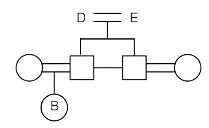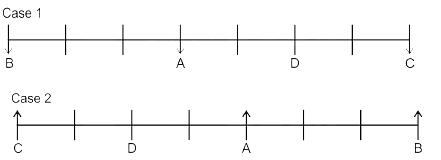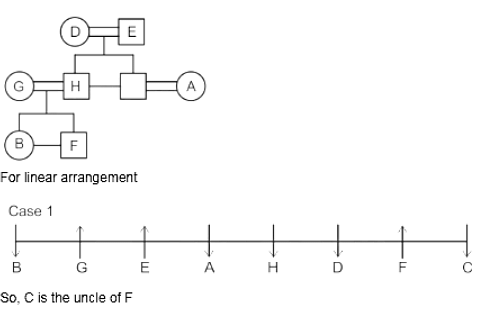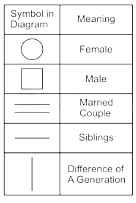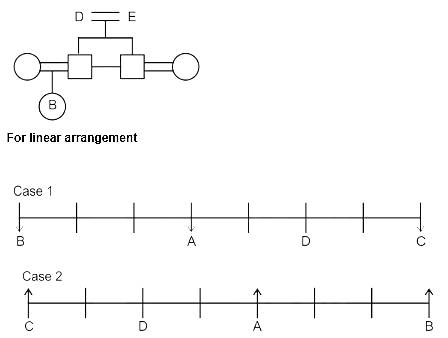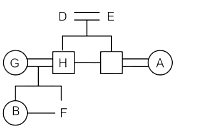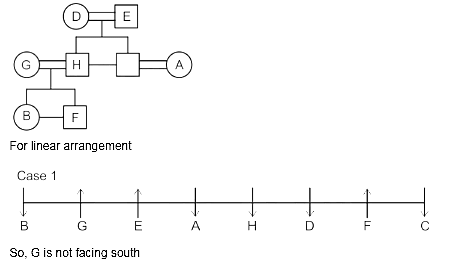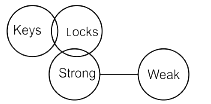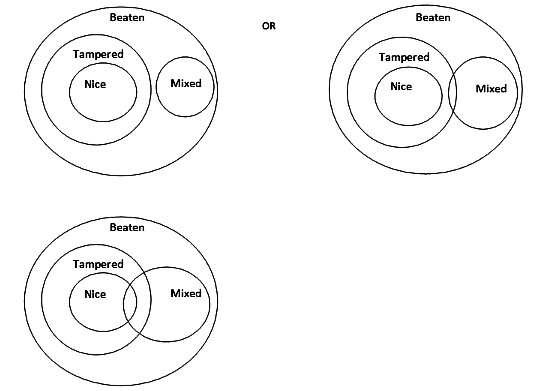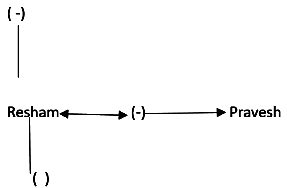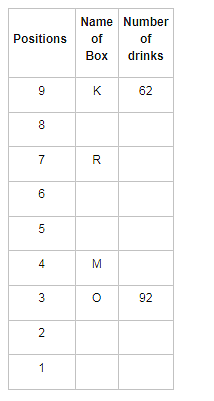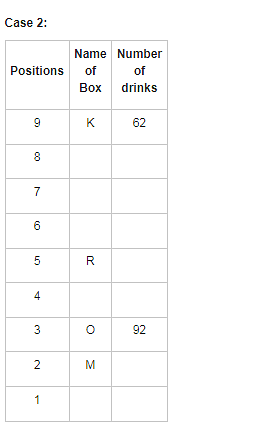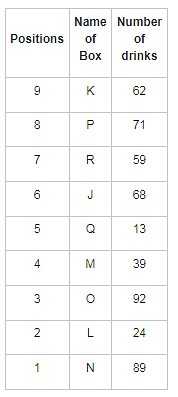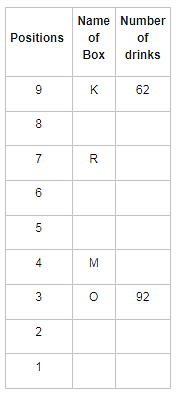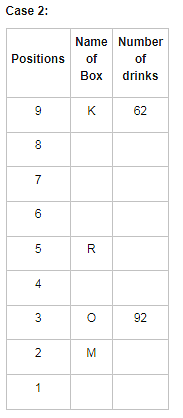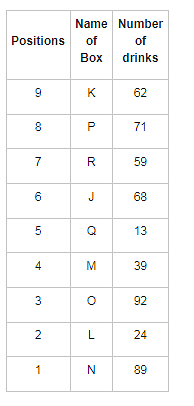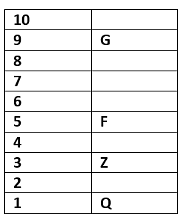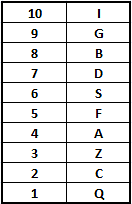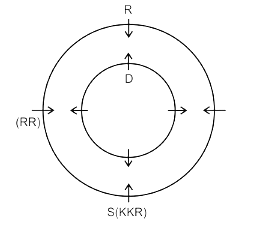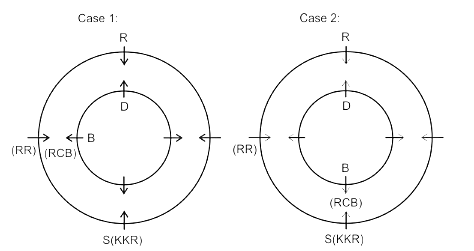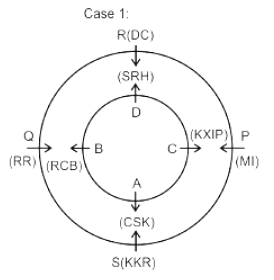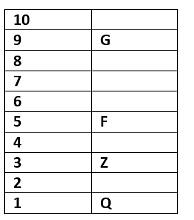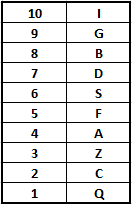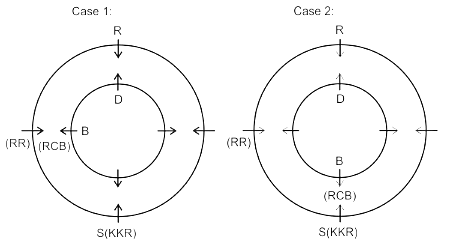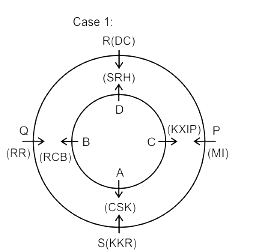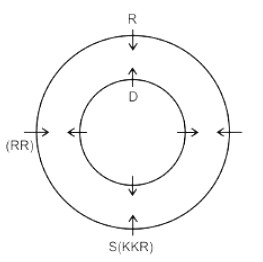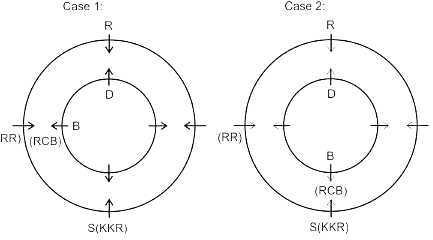NABARD Assistant Manager Grade 'A' Mock Test - 1 - Bank Exams MCQ
30 Questions MCQ Test NABARD Assistant Manager Grade A Mock Test Series 2024 - NABARD Assistant Manager Grade 'A' Mock Test - 1
Study the following information carefully and answer the questions accordingly:
Eight friends, Shaina, Rani, Tanya, Reva, Sonal, Mehak, Pushpa and Diva are seated in a straight line but not necessarily in the same order. Some of them are facing south while some are facing north. Only two people sit between Sonal and Rani. Only three people sit to the left of Sonal. Sonal faces south. Mehak sits third to the right of Diva. Diva is not an immediate neighbour of neither Sonal nor Rani. Diva does not sit at any of the extreme ends of the line. Both the immediate neighbours of Reva face north. Reva is not an immediate neighbour of Diva. Only one person sits between Reva and Shaina. Shaina faces the same direction as Diva. The immediate neighbours of Rani face opposite directions (ie if one person is facing north then the other person faces south and vice versa). Persons sitting at the extreme ends face opposite directions. Tanya faces a direction opposite to that of Reva.
Q. Who two are the immediate neighbors of Reva in the given arrangement?
These questions are based on the following information
A family of 8 members A, B, C, D, E, F, G and H are sitting in a straight line facing both directions north as well as south. There are 3 generations having 3 married couples among them.
G and H do not face same direction. D sits 2nd to the left of A and 2nd to the right of C as well. E and his grandson face same direction. The son of H faces opposite direction to his grandmother but same direction as his mother. B is youngest female member of the family who sits on one of the ends of the line. G faces the opposite direction to her daughter. D is married to E and they have only two sons. H is father of F who sits 2nd to the left of H and faces north direction. A is the aunt of B and sits 3rd to her left. A faces same direction as B. G and H are married couples and two people sit between them. F is the grandson of D who is the mother of C. F is not immediate neighbor of A.
Q. Who is the uncle of F?
| 1 Crore+ students have signed up on EduRev. Have you? Download the App |
Study the following information carefully and answer the questions accordingly:
Eight friends, Shaina, Rani, Tanya, Reva, Sonal, Mehak, Pushpa and Diva are seated in a straight line but not necessarily in the same order. Some of them are facing south while some are facing north. Only two people sit between Sonal and Rani. Only three people sit to the left of Sonal. Sonal faces south. Mehak sits third to the right of Diva. Diva is not an immediate neighbour of neither Sonal nor Rani. Diva does not sit at any of the extreme ends of the line. Both the immediate neighbours of Reva face north. Reva is not an immediate neighbour of Diva. Only one person sits between Reva and Shaina. Shaina faces the same direction as Diva. The immediate neighbours of Rani face opposite directions (ie if one person is facing north then the other person faces south and vice versa). Persons sitting at the extreme ends face opposite directions. Tanya faces a direction opposite to that of Reva.
Q. Which person is facing the same direction as the direction of Shaina?
These questions are based on the following information
A family of 8 members A, B, C, D, E, F, G and H are sitting in a straight line facing both directions north as well as south. There are 3 generations having 3 married couples among them.
G and H do not face same direction. D sits 2nd to the left of A and 2nd to the right of C as well. E and his grandson face same direction. The son of H faces opposite direction to his grandmother but same direction as his mother. B is youngest female member of the family who sits on one of the ends of the line. G faces the opposite direction to her daughter. D is married to E and they have only two sons. H is father of F who sits 2nd to the left of H and faces north direction. A is the aunt of B and sits 3rd to her left. A faces same direction as B. G and H are married couples and two people sit between them. F is the grandson of D who is the mother of C. F is not immediate neighbor of A.
Q. Who among the following is not facing south?
Study the following information carefully and answer the questions accordingly:
Eight friends, Shaina, Rani, Tanya, Reva, Sonal, Mehak, Pushpa and Diva are seated in a straight line but not necessarily in the same order. Some of them are facing south while some are facing north. Only two people sit between Sonal and Rani. Only three people sit to the left of Sonal. Sonal faces south. Mehak sits third to the right of Diva. Diva is not an immediate neighbour of neither Sonal nor Rani. Diva does not sit at any of the extreme ends of the line. Both the immediate neighbours of Reva face north. Reva is not an immediate neighbour of Diva. Only one person sits between Reva and Shaina. Shaina faces the same direction as Diva. The immediate neighbours of Rani face opposite directions (ie if one person is facing north then the other person faces south and vice versa). Persons sitting at the extreme ends face opposite directions. Tanya faces a direction opposite to that of Reva.
Q. Who two are sitting at the extreme ends of the row?
In the question below are given three statements followed by two conclusions I and II. You have to take the given statements to be true even if they seem to be at variance from commonly known facts. Read all the conclusions and then decide which of the given conclusions logically follows from the given statements disregarding commonly known facts.
Statements:
Only a few keys are locks
Few locks are strong
No strong is weak
Conclusions:
I. Some locks are keys.
II. Some locks are not weak.
In each question below some statements followed by four conclusions numbered I, II, III and IV are given. You have to take the given statements to be true even if they seem to be at variance with commonly known facts and then decide which of the given conclusions logically follows from the two given statements, disregarding commonly known facts.
Statements:
All nice are tampered.
All tampered are beaten.
All mixed are beaten.
Conclusions:
I. No tampered is mixed.
II. Some mixed are tampered.
III. Some beaten are nice.
IV. Some mixed are nice
In the question below are given three statements followed by two conclusions numbered I, and II. You have to take the given statements to be true even if they seem to be at variance with commonly known facts. Read all the conclusions and then decide which of the given conclusions logically follows from the given statements disregarding commonly known facts.
Statements:
All cow is dog.
Some cow is fox.
Some fox is ox.
Conclusions:
I. Some dogs are fox.
II. No ox are cow.
Study the following information carefully and answer these questions given below:-
Pointing to Resham in the photograph, Pravesh said, “His mother has only one grandchild whose mother is my sister”. How is Pravesh related to Resham?
Read the given information and carefully answer the following questions.
There are nine boxes from J, K, L, M, N, O, P, Q and R which are placed one above the other. Each box has a different number of drinks such as 71, 24, 68, 89, 39, 59, 62, 92 and 13. The lowermost box is numbered as one and above as two and so on. All the above information is not necessary in the same order.
The position of box M is even number. Box R has kept three boxes above the box M. Box P is kept one of the positions above box R. Box J is placed at even position above box M. The number of drinks inbox M is thrice the number of drinks in box Q. Box R has 35 drinks more than box L. Box K is placed at the topmost position. Box O has the highest amount of drinks and kept at the third position from the bottom. The difference between the number of drinks in box K and box O is 30. Box N has 89 drinks that are kept at one of the positions below box M but not immediately below it. Box L is kept one of the positions below box O but above N. There are even numbers of drinks in box J.
Q. How many drinks are kept in box P?
Read the following information carefully and answer the question that follows:
There are six persons Sumit, Alisha, Kavya, Helen, Aishwarya and Sonia, who got different marks in the examination. Sumit got less marks than only Kavya and Sonia. Alisha got more marks than Aishwarya, who did not get the lowest marks in the examination. The second lowest person got 65 marks.
Q. Who scored the third highest marks?
Read the given information and carefully answer the following questions.
There are nine boxes from J, K, L, M, N, O, P, Q and R which are placed one above the other. Each box has a different number of drinks such as 71, 24, 68, 89, 39, 59, 62, 92 and 13. The lowermost box is numbered as one and above as two and so on. All the above information is not necessary in the same order.
The position of box M is even number. Box R has kept three boxes above the box M. Box P is kept one of the positions above box R. Box J is placed at even position above box M. The number of drinks inbox M is thrice the number of drinks in box Q. Box R has 35 drinks more than box L. Box K is placed at the topmost position. Box O has the highest amount of drinks and kept at the third position from the bottom. The difference between the number of drinks in box K and box O is 30. Box N has 89 drinks that are kept at one of the positions below box M but not immediately below it. Box L is kept one of the positions below box O but above N. There are even numbers of drinks in box J.
Q. How many boxes are kept between box R and the box that has 92 drinks?
In these questions relationship between different elements is shown in the Statements. These Statements are followed by conclusions. You have to find out which of the conclusions logically follows from the given statements.
Statements: X ? Y= Z ? A < B > C
Conclusion:
I. C < Z
II. B < Y
III. X > A
IV. A < C
In the following question assuming the given statements to be true, find which of the conclusion among given conclusion is/are definitely true and then give your answer accordingly.
Statements: 9 < 5 ? 3 > 7; 6 < 5 < 2; 3 < 2; 9 ? 6
Conclusions:
I. 9 > 2
II. 3 > 6
III 7 ? 6
Study the following information and answer it carefully:
Ten persons F, B, D, S, I, A, Q, G, Z and C are lives on 10 floor building. The lowermost floor is numbered 1, above the floor numbered 2, & so on.
Three persons are living between G & F. G lives an odd numbered floor but above floor numbered 5. Only one person lives between Q & Z who is lives an odd numbered floor. One person lives between C & A. Two floors are there between D & I. Neither F nor G was immediately above or immediately below of C.B lives above S. I is not the immediate neighbour of B.
Q. I, lives on which of the following floor among the following?
Study the following information carefully and answer the given questions:
Eight friends A, B, C, D, P, Q, R and S are sitting in two circles in such a manner that each member of the inner circle sits exactly opposite to the member of the outer circle. The members sitting in the outer circle are P, Q, R and S and all of them are facing towards the Centre while the members of the inner circle are A, B, C and D and they are facing away from the Centre. Each of them likes different IPL teams DC, RCB, MI, CSK, KXIP, SRH, KKR and RR but not necessarily in the same order.
D likes neither RCB nor KXIP and faces R, who neither likes RR nor KKR. The person who likes SRH faces the person who likes DC. A, who likes CSK, faces the immediate neighbor of the person who likes MI. R sits second to the left of S. The person likes KXIP and DC are in a separate circle. The person who likes RR sits on the immediate left of S. Q, who does not like MI, does not face A. The person who likes RR and KKR are immediate neighbors, and one of them faces B, who likes RCB. The person who likes SRH and CSK sit in the same circle but they are not immediate neighbors. R does not like MI.
Q. Who among the following like MI?
Study the following information and answer it carefully:
Ten persons F, B, D, S, I, A, Q, G, Z and C are lives on 10 floor building. The lowermost floor is numbered 1, above the floor numbered 2, & so on.
Three persons are living between G & F. G lives an odd numbered floor but above floor numbered 5. Only one person lives between Q & Z who is lives an odd numbered floor. One person lives between C & A. Two floors are there between D & I. Neither F nor G was immediately above or immediately below of C. B lives above S. I is not the immediate neighbour of B.
Q. How many persons are living below F?
Study the following information carefully and answer the given questions:
Eight friends A, B, C, D, P, Q, R and S are sitting in two circles in such a manner that each member of the inner circle sits exactly opposite to the member of the outer circle. The members sitting in the outer circle are P, Q, R and S and all of them are facing towards the Centre while the members of the inner circle are A, B, C and D and they are facing away from the Centre. Each of them likes different IPL teams DC, RCB, MI, CSK, KXIP, SRH, KKR and RR but not necessarily in the same order.
D likes neither RCB nor KXIP and faces R, who neither likes RR nor KKR. The person who likes SRH faces the person who likes DC. A, who likes CSK, faces the immediate neighbor of the person who likes MI. R sits second to the left of S. The person likes KXIP and DC are in a separate circle. The person who likes RR sits on the immediate left of S. Q, who does not like MI, does not face A. The person who likes RR and KKR are immediate neighbors, and one of them faces B, who likes RCB. The person who likes SRH and CSK sit in the same circle but they are not immediate neighbors. R does not like MI.
Q. Who among the following are immediate neighbors of the one who like DC?
Study the following information carefully and answer the questions below.
A certain number of people are sitting in a row facing North. S sits at one of the ends and there are two people between S and R. There are as many people to the right of V as there are to the left of V. W is third to the left of R who sits fourth from one of the extreme ends of the row. Q sits at one of the extreme ends of the row. W does not sit at any of the extreme ends of the row. There are five persons sitting between Q and T. U sits exactly in the middle of Q and T. Two persons sit between T and V. There are as many persons sitting between W and S as many are sitting between W and T.
Q. Who is sitting third to the right of W?
Study the following information carefully and answer the given questions:
Eight friends A, B, C, D, P, Q, R and S are sitting in two circles in such a manner that each member of the inner circle sits exactly opposite to the member of the outer circle. The members sitting in the outer circle are P, Q, R and S and all of them are facing towards the Centre while the members of the inner circle are A, B, C and D and they are facing away from the Centre. Each of them likes different IPL teams DC, RCB, MI, CSK, KXIP, SRH, KKR and RR but not necessarily in the same order.
D likes neither RCB nor KXIP and faces R, who neither likes RR nor KKR. The person who likes SRH faces the person who likes DC. A, who likes CSK, faces the immediate neighbor of the person who likes MI. R sits second to the left of S. The person likes KXIP and DC are in a separate circle. The person who likes RR sits on the immediate left of S. Q, who does not like MI, does not face A. The person who likes RR and KKR are immediate neighbors, and one of them faces B, who likes RCB. The person who likes SRH and CSK sit in the same circle but they are not immediate neighbors. R does not like MI.
Q. Four of the following five are alike in a certain way based on the given information and so form a group. Find the one which does not belong to the group?
Each question below has two blanks, each blank indicating that something has been omitted. Choose the set of words for each blank that best fits the meaning of the sentence as whole.
The puzzle that we _________ today was quite a hard _______ to crack.
Read the passage given below and answer the questions that follow by choosing the correct/most appropriate options:
India was one of the first countries in the world to introduce a policy for family planning. But the issue did not receive sustained attention from the government until the mid-1960s when the population growing at an increasing rate raised the spectre of persistent food shortages, stunted economic growth and diminished international strategic autonomy. Given the limited reach of television and radio, which covered barely a fourth of the population, the Indian government relied heavily on the Indian Posts and Telegraphs Department (P&T) to spread awareness about the need for population control. The P&T used commemorative and definitive postage stamps, printed slogans/advertisements on postal stationery and slogan postmarks to communicate the importance and advertise the methods of family planning. In addition, permanent enamelled metal signboards were supposedly placed on the premises of the nearly one lakh post offices across India.
On 12 December 1966, the Indian Posts and Telegraphs Department issued two-and-a-half million copies of the commemorative postage stamp captioned ‘Plan Your Family: Family Planning Week. The information brochure issued along with the stamp justified the emphasis on family planning considering the “population explosion” in a country that “comprises 14% of the world’s population… on 2.4% of the world’s land area.” It added that the government was setting up research and training institutions to facilitate family planning and solicited “the cooperation and active participation of all the people in this National Task.” The stamp showing a happy family of four including two children—a boy not yet ten standing next to his father and a less than two-year-old girl in her mother’s arms. The cachet of the First Day Cover (FDC) of this stamp, too, showed a family of four but here the boy is a toddler while the girl is older. Interestingly, the postmark used to cancel the stamp on the first day of issue conveys two different messages in Hindi (‘???? ?????? ??? ?? ????’, that is, ‘A small family is the foundation of happiness) and English (‘A small family is a happy family’). So, while the caption of the stamp exhorts people to plan their families, the message in the postmark extols the virtues of a small family. In later family planning messages, ‘Plan Your Family’ is also translated as ‘?? ????? ???? ???? (Fewer children, happy life)’.
From the first commemorative issue, we learn two things about the government’s approach. First, the ideal was a gender-balanced family ____ four with adequate spacing between the birth of the children. Second, the government’s initiative was limited to creating awareness, exhorting people to voluntarily limit their family size, and making contraceptives available.
The year 1970 witnessed innovations in the use of postal channels for promoting family planning. The India National Philatelic Exhibition that was held in New Delhi featured family planning as a major theme. In another first, the information brochures of stamps on institutions/organisations began to highlight family planning. The brochure of the commemorative stamp on the golden jubilee of the Indian Red Cross Society (1970) noted that it “lays emphasis on family planning work” and was “running over 300 family planning centres in the country.” Later, commemoratives on the centenary of the Young Women’s Christian Association (1975), the golden jubilee of the Federation of Indian Chambers of Commerce & Industry (1977) and the centenary of the PHD Chamber of Commerce and Industry (2005), too, emphasised their contribution to family planning.
Q. Which of the following is/are correct according to the given passage?
A. The year 1977 witnessed innovations in the use of postal channels for promoting family planning, the India National Philatelic Exhibition that was held in New Delhi featured family planning as a major theme.
B. The information brochure issued in 1966 along with the stamp justified the emphasis on family planning considering the “population explosion”
in a country that “comprises 14% of the world’s population… on 2.4% of the world’s land area."
C. The government’s initiative was limited to creating awareness, exhorting people to voluntarily limit their family size.
Each question below has two blanks, each blank indicating that something has been omitted. Choose the set of words for each blank that best fits the meaning of the sentence as whole.
During her research, Seema __________ dozens of objects that she couldn’t include in the book, but also couldn’t ________.
Read the passage given below and answer the questions that follow by choosing the correct/most appropriate options:
India was one of the first ountries in the world to introduce a policy for family planning. But the issue did not receive sustained attention from the government until the mid-1960s when the population growing at an increasing rate raised the spectre of persistent food shortages, stunted economic growth and diminished international strategic autonomy. Given the limited reach of television and radio, which covered barely a fourth of the population, the Indian government relied heavily on the Indian Posts and Telegraphs Department (P&T) to spread awareness about the need for population control. The P&T used commemorative and definitive postage stamps, printed slogans/advertisements on postal stationery and slogan postmarks to communicate the importance and advertise the methods of family planning. In addition, permanent enamelled metal signboards were supposedly placed on the premises of the nearly one lakh post offices across India.
On 12 December 1966, the Indian Posts and Telegraphs Department issued two-and-a-half million copies of the commemorative postage stamp captioned ‘Plan Your Family: Family Planning Week. The information brochure issued along with the stamp justified the emphasis on family planning considering the “population explosion” in a country that “comprises 14% of the world’s population… on 2.4% of the world’s land area.” It added that the government was setting up research and training institutions to facilitate family planning and solicited “the cooperation and active participation of all the people in this National Task.” The stamp showing a happy family of four including two children—a boy not yet ten standing next to his father and a less than two-year-old girl in her mother’s arms. The cachet of the First Day Cover (FDC) of this stamp, too, showed a family of four but here the boy is a toddler while the girl is older. Interestingly, the postmark used to cancel the stamp on the first day of issue conveys two different messages in Hindi (‘???? ?????? ??? ?? ????’, that is, ‘A small family is the foundation of happiness) and English (‘A small family is a happy family’). So, while the caption of the stamp exhorts people to plan their families, the message in the postmark extols the virtues of a small family. In later family planning messages, ‘Plan Your Family’ is also translated as ‘?? ????? ???? ???? (Fewer children, happy life)’.
From the first commemorative issue, we learn two things about the government’s approach. First, the ideal was a gender-balanced family ____ four with adequate spacing between the birth of the children. Second, the government’s initiative was limited to creating awareness, exhorting people to voluntarily limit their family size, and making contraceptives available.
The year 1970 witnessed innovations in the use of postal channels for promoting family planning. The India National Philatelic Exhibition that was held in New Delhi featured family planning as a major theme. In another first, the information brochures of stamps on institutions/organisations began to highlight family planning. The brochure of the commemorative stamp on the golden jubilee of the Indian Red Cross Society (1970) noted that it “lays emphasis on family planning work” and was “running over 300 family planning centres in the country.” Later, commemoratives on the centenary of the Young Women’s Christian Association (1975), the golden jubilee of the Federation of Indian Chambers of Commerce & Industry (1977) and the centenary of the PHD Chamber of Commerce and Industry (2005), too, emphasised their contribution to family planning.
Q. Given below is a word, followed by three sentences that consist of that word. Identify the sentence(s) that express(es) the meaning of that word.
CENTENARY
A. Prime Minister Modi planted a 'kalpatru' tree on the occasion of the centenary celebration of the Bihar Vidhan Sabha Bhawan.
B. James Joyces Ulysses was published in 1922 and Ireland planned a week-long celebration of the centenary.
C. The postal service's 'pin code' turned 50 this year and marked its centenary.
Each question below has two blanks, each blank indicating that something has been omitted. Choose the set of words for each blank that best fits the meaning of the sentence as whole.
People these days, do not pay attention to accident victims showing an _______ behaviour, rather than ___________ for help.
Read the passage given below and answer the questions that follow by choosing the correct/most appropriate options:
India was one of the first countries in the world to introduce a policy for family planning. But the issue did not receive sustained attention from the government until the mid-1960s when the population growing at an increasing rate raised the spectre of persistent food shortages, stunted economic growth and diminished international strategic autonomy. Given the limited reach of television and radio, which covered barely a fourth of the population, the Indian government relied heavily on the Indian Posts and Telegraphs Department (P&T) to spread awareness about the need for population control. The P&T used commemorative and definitive postage stamps, printed slogans/advertisements on postal stationery and slogan postmarks to communicate the importance and advertise the methods of family planning. In addition, permanent enamelled metal signboards were supposedly placed on the premises of the nearly one lakh post offices across India.
On 12 December 1966, the Indian Posts and Telegraphs Department issued two-and-a-half million copies of the commemorative postage stamp captioned ‘Plan Your Family: Family Planning Week. The information brochure issued along with the stamp justified the emphasis on family planning considering the “population explosion” in a country that “comprises 14% of the world’s population… on 2.4% of the world’s land area.” It added that the government was setting up research and training institutions to facilitate family planning and solicited “the cooperation and active participation of all the people in this National Task.” The stamp showing a happy family of four including two children—a boy not yet ten standing next to his father and a less than two-year-old girl in her mother’s arms. The cachet of the First Day Cover (FDC) of this stamp, too, showed a family of four but here the boy is a toddler while the girl is older. Interestingly, the postmark used to cancel the stamp on the first day of issue conveys two different messages in Hindi (‘???? ?????? ??? ?? ????’, that is, ‘A small family is the foundation of happiness) and English (‘A small family is a happy family’). So, while the caption of the stamp exhorts people to plan their families, the message in the postmark extols the virtues of a small family. In later family planning messages, ‘Plan Your Family’ is also translated as ‘?? ????? ???? ???? (Fewer children, happy life)’.
From the first commemorative issue, we learn two things about the government’s approach. First, the ideal was a gender-balanced family ____ four with adequate spacing between the birth of the children. Second, the government’s initiative was limited to creating awareness, exhorting people to voluntarily limit their family size, and making contraceptives available.
The year 1970 witnessed innovations in the use of postal channels for promoting family planning. The India National Philatelic Exhibition that was held in New Delhi featured family planning as a major theme. In another first, the information brochures of stamps on institutions/organisations began to highlight family planning. The brochure of the commemorative stamp on the golden jubilee of the Indian Red Cross Society (1970) noted that it “lays emphasis on family planning work” and was “running over 300 family planning centres in the country.” Later, commemoratives on the centenary of the Young Women’s Christian Association (1975), the golden jubilee of the Federation of Indian Chambers of Commerce & Industry (1977) and the centenary of the PHD Chamber of Commerce and Industry (2005), too, emphasised their contribution to family planning.
Q. Choose the Antonym of the word 'sustained'.
In each of the questions, a sentence is divided into five parts namely A, B, C, D and E in which two of the parts have some grammatical or contextual errors in them. You have to identify which pair among the given alternatives represents the parts that contain those errors. If none of the part has any error, then, mark option 5, i.e., ‘No error’ as your answer.
Describe the election as “a U.S. Brexit,” (A) the authors warned that much (B) of the risk would arise from (C) the result being contested — whether (D) or not Trump emerged victory (E).
India was one of the first countries in the world to introduce a policy for family planning. But the issue did not receive sustained attention from the government until the mid-1960s when the population growing at an increasing rate raised the spectre of persistent food shortages, stunted economic growth and diminished international strategic autonomy. Given the limited reach of television and radio, which covered barely a fourth of the population, the Indian government relied heavily on the Indian Posts and Telegraphs Department (P&T) to spread awareness about the need for population control. The P&T used commemorative and definitive postage stamps, printed slogans/advertisements on postal stationery and slogan postmarks to communicate the importance and advertise the methods of family planning. In addition, permanent enamelled metal signboards were supposedly placed on the premises of the nearly one lakh post offices across India.
On 12 December 1966, the Indian Posts and Telegraphs Department issued two-and-a-half million copies of the commemorative postage stamp captioned ‘Plan Your Family: Family Planning Week. The information brochure issued along with the stamp justified the emphasis on family planning considering the “population explosion” in a country that “comprises 14% of the world’s population… on 2.4% of the world’s land area.” It added that the government was setting up research and training institutions to facilitate family planning and solicited “the cooperation and active participation of all the people in this National Task.” The stamp showing a happy family of four including two children—a boy not yet ten standing next to his father and a less than two-year-old girl in her mother’s arms. The cachet of the First Day Cover (FDC) of this stamp, too, showed a family of four but here the boy is a toddler while the girl is older. Interestingly, the postmark used to cancel the stamp on the first day of issue conveys two different messages in Hindi (‘???? ?????? ??? ?? ????’, that is, ‘A small family is the foundation of happiness) and English (‘A small family is a happy family’). So, while the caption of the stamp exhorts people to plan their families, the message in the postmark extols the virtues of a small family. In later family planning messages, ‘Plan Your Family’ is also translated as ‘?? ????? ???? ???? (Fewer children, happy life)’.
From the first commemorative issue, we learn two things about the government’s approach. First, the ideal was a gender-balanced family ____ four with adequate spacing between the birth of the children. Second, the government’s initiative was limited to creating awareness, exhorting people to voluntarily limit their family size, and making contraceptives available.
The year 1970 witnessed innovations in the use of postal channels for promoting family planning. The India National Philatelic Exhibition that was held in New Delhi featured family planning as a major theme. In another first, the information brochures of stamps on institutions/organisations began to highlight family planning. The brochure of the commemorative stamp on the golden jubilee of the Indian Red Cross Society (1970) noted that it “lays emphasis on family planning work” and was “running over 300 family planning centres in the country.” Later, commemoratives on the centenary of the Young Women’s Christian Association (1975), the golden jubilee of the Federation of Indian Chambers of Commerce & Industry (1977) and the centenary of the PHD Chamber of Commerce and Industry (2005), too, emphasised their contribution to family planning.
Q. In this question, a sentence (in bold) from the passage has been divided into four parts (A), (B), (C) and (D). Read the sentence to find out whether there is any grammatical error in it. The error if any will be in one part of the sentence. If there is No error the answer is 'No Error/(E)'. Ignore the error of punctuation if any.
The stamp showing a happy family(A)/ of four including two children—a boy not yet ten(B)/ standing next to his father and(C)/ a less than two-year-old girl in her mother’s arms. (D)/ No Error(E)
In each of the questions, a sentence is divided into five parts namely A, B, C, D and E in which two of the parts have some grammatical or contextual errors in them. You have to identify which pair among the given alternatives represents the parts that contain those errors. If none of the part has any error, then, mark option 5, i.e., ‘No error’ as your answer.
There have been regular low-intensity (A)/ skirmishes among Iran and the US in (B)/ the Gulf waters and in Iraq (C)/ itself ever since Trump reinstated (D)/ sanctions on Iran at November 2018 (E).
What is the central theme of the passage?
|
14 docs|63 tests
|
|
14 docs|63 tests
|







